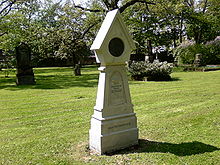Alfred Clebsch
Rudolf Friedrich Alfred Clebsch (born January 19, 1833 in Königsberg ; † November 7, 1872 in Göttingen ) was a German mathematician who made significant contributions to algebraic geometry and invariant theory.
Life
Clebsch studied mathematics at the Albertina in Königsberg from 1850 . Among his teachers there was in particular Otto Hesse , who in turn was a pupil of Carl Gustav Jacob Jacobi . In 1854 he received his doctorate there with the work on the motion of an ellipsoid in a liquid . Clebsch then worked from 1854 in Berlin as a teacher at various schools. In 1858 he completed his habilitation in mathematical physics at Berlin University .
In the autumn of 1858 Clebsch accepted a call as professor of analytical mechanics at the Polytechnic School in Karlsruhe , where he worked from 1858 to 1863. In 1863 he became a full professor in Gießen , then in 1868 in Göttingen , where he died of diphtheria in 1872 at the age of only 39 when he was rector .
In 1864 he was elected a corresponding member of the Göttingen Academy of Sciences . From 1868 he was a corresponding member of the Prussian and from 1869 of the Bavarian Academy of Sciences .
His collaboration with Paul Gordan led to the development of the Clebsch-Gordan coefficients from the representation theory of the rotating group, which are widely used in quantum mechanics . As the center of his own school of algebraic geometry, he further developed Bernhard Riemann's ideas on the geometric application of function theory . The strong geometric orientation of his school was viewed with skepticism by the Berlin mathematicians around Weierstrass, Kronecker and Kummer. After the death of Clebsch, his pupil Felix Klein took over the management of his school and the opposition of the Berlin mathematicians, who insisted on greater precision, carried over to them, which gave rise to the germ of the contrast between Berlin and Göttingen mathematicians in the late 19th century the leading schools in Germany.
Together with Carl Gottfried Neumann , he founded the mathematical journal Mathematische Annalen in 1868 , which for a long time was one of the world's most respected mathematical journals.
The grave of Clebsch is in the Bartholomäusfriedhof in Göttingen. For a long time after 1960 the tomb was in a poor and incomplete condition. In 2006 the tombstone was restored, with the part above the scroll being recreated in a simplified form. The modern medallion has Thomas Duttenhoefer created based on the original of 2006. The inauguration took place on May 23, 2006.
Fonts
- Solid body elasticity theory . Teubner, Leipzig (1862)
- with Paul Gordan: Theory of Abelian Functions . Leipzig (1866)
- Theory of binary algebraic forms . Leipzig (1872)
- Théorie de l´Élasticité des Corps Solides . Traduite par Barré de Saint-Venant et Flamant , avec des notes étendues de Saint-Venant. Dunod, Paris (1883)
Individual evidence
- ↑ published in Crelles Journal Vol. 52 (1856): pp. 102–32 ( pdf )
- ↑ Holger Krahnke: The members of the Academy of Sciences in Göttingen 1751-2001 (= Treatises of the Academy of Sciences in Göttingen, Philological-Historical Class. Volume 3, Vol. 246 = Treatises of the Academy of Sciences in Göttingen, Mathematical-Physical Class. Episode 3, vol. 50). Vandenhoeck & Ruprecht, Göttingen 2001, ISBN 3-525-82516-1 , p. 60.
- ^ Members of the previous academies. Alfred Clebsch. Berlin-Brandenburg Academy of Sciences and Humanities , accessed on March 9, 2015 .
- ^ Member entry by Alfred Clebsch (with a link to an obituary) at the Bavarian Academy of Sciences , accessed on January 17, 2017.
literature
- Werner Burau : Clebsch, Rudolf Friedrich Alfred . In: Charles Coulston Gillispie (Ed.): Dictionary of Scientific Biography . tape 3 : Pierre Cabanis - Heinrich von Dechen . Charles Scribner's Sons, New York 1971, p. 313-315 .
- Richard Börnstein : Alfred Clebsch (obituary). In: New Prussian Provincial Papers . Fourth episode, volume 9, Königsberg i. Pr. 1872, pp. 653-655.
- Theodor Husemann : Clebsch, Rudolf Friedrich Alfred . In: Allgemeine Deutsche Biographie (ADB). Volume 4, Duncker & Humblot, Leipzig 1876, p. 299 f.
- Johannes ES Schmidt: The French Cathedral School and the French Gymnasium in Berlin. Student memories 1848–1861. Edited and commented by Rüdiger RE Fock. Publishing house Dr. Kovač , Hamburg 2008, ISBN 978-3-8300-3478-0 , p. 54 f.
- Albrecht Saathoff. Göttingen's cemeteries. The place of his great dead . Heinz Reise-Verlag, Göttingen 1954. (p. 19 photo of the tomb)
- Felix Klein: Lectures on the development of mathematics in the 19th century. Chapter 7: Clebsch and his school, p. 297ff, Springer Verlag, 1979 digitized in full text
- Igor Schafarewitsch On the 150th birthday of Alfred Clebsch , Mathematische Annalen, Vol. 266, 1983, pp. 135–140
- Wilhelm Süss : Clebsch, Rudolf Friedrich Alfred. In: New German Biography (NDB). Volume 3, Duncker & Humblot, Berlin 1957, ISBN 3-428-00184-2 , p. 279 ( digitized version ).
- Jürgen Weiß: Successful old 68ers. Mathematical annals - messages BG Teubner - Alfred Clebsch - Felix Klein - Carl Neumann. Preface: Jürgen Jost, Leipzig. EAGLE 101st Edition at Gutenbergplatz, Leipzig 2018, ISBN 978-3-95922-101-6 .
Web links
- Literature by and about Alfred Clebsch in the catalog of the German National Library
- John J. O'Connor, Edmund F. Robertson : Alfred Clebsch. In: MacTutor History of Mathematics archive .
- Short biography at the University of Göttingen
- Lecture series on important Göttingen mathematicians, inauguration of the grave of Clebsch
- Alfred Clebsch in the Mathematics Genealogy Project
- Alfred Clebsch in the Internet Archive
| personal data | |
|---|---|
| SURNAME | Clebsch, Alfred |
| ALTERNATIVE NAMES | Clebsch, Rudolf Friedrich Alfred (full name) |
| BRIEF DESCRIPTION | German mathematician |
| DATE OF BIRTH | January 19, 1833 |
| PLACE OF BIRTH | Koenigsberg |
| DATE OF DEATH | November 7, 1872 |
| Place of death | Goettingen |

